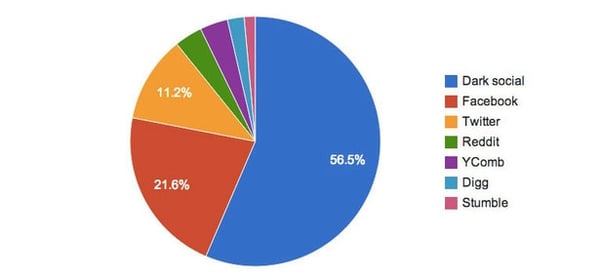
Surely you’ve heard of marketing funnels and sales funnels, but have you heard of the dark funnel?
If it sounds mysterious, that’s because it is. Both because it’s rarely talked about and because, by nature, it’s hard to know much about. Which is a problem for brands and marketers, because it’s creating a big blind spot in attribution that many of us have been completely... well, in the dark about.
Even if you haven’t heard of the dark funnel or dark social, there's a good chance that your marketing is being affected by them.
Here’s everything you need to know about what the dark funnel and dark social are, how they’re affecting your marketing without you knowing it, and how you can keep an eye out for them.
What is the Dark Funnel?
The blanks we’re left with when a consumer converts and we don’t know what contributed to it - that’s the dark funnel. It includes all the untrackable actions consumers take (both online and off) to discover, research and make purchase decisions about your product or service.
It covers things like visits to third-party platforms, organic social post views, word-of-mouth, video views and more.
We know these unseen stops along the buyer’s journey are happening, but we can’t see them.
For instance, if someone follows your brand on social media for years, then visits your website directly and buys. Their purchase would show up as direct traffic, but putting it in that bucket doesn’t tell the whole story.
According to Chris Walker, CEO of Refine Labs, “The thing that connects all of these channels is either direct communication between peers, or it's happening on third-party content platforms that have privacy policies. So you can't get hold of any data to track, and because companies can't track it effectively, most of them don't execute on them.”
Bottom line: The buyer’s journey is more complex than we can see with the tools we currently have, leading us to over- or under-attribute certain actions to one source over another. And more often than not, we aren’t even aware we’re doing it!
What is Dark Social?
Dark social on the other hand includes touchpoints from social media (and in-person social interactions) that you can’t track. It includes the conversations that are happening both online and offline that contribute to a consumer’s product discovery, product research and purchase decision.
Think: forgoing the “Share” button on an article and texting a link to a friend instead. Again, such an action would be falsely attributed to direct traffic.
Other sources for dark social include word-of-mouth, emails, direct messages, texts and more.
For some, these dark social traffic sources contribute to a large chunk of the pie.
According to Alexis C. Madrigal, contributing writer for the Atlantic, dark social is responsible for 56.5% of their social traffic – which tallies up to more than 2.5x the traffic Facebook brings them.

(Photo courtesy of the Atlantic)
Why Dark Social and the Dark Funnel are Important in 2022
The digital buyer’s journey isn’t a straight line, and it isn’t always visible by any means. Especially in 2022, when privacy updates and attribution changes are taking center stage.
Privacy updates, like Apple’s “Ask App Not to Track” prompts, are hiding consumer data, making it increasingly difficult to gather information on the buyer’s journey.
We’re witnessing the death of the third-party cookie.
And, in September of 2021, Google changed its default attribution model, further deemphasizing the idea of a neat and tidy way of measuring which actions should receive credit. The tech giant made the switch from last-click attribution to data modeling, in part to use machine learning to fill the gaps that last-click, and other attribution models can’t (aka dark funnel actions!).
Aside from all of these changes making it harder to see how consumers find, research and purchase from brands, dark social is here to make matters even more complicated.
It’s clear that dark social is driving more traffic than we know. Whether it’s a social mention or piece of user-generated content that doesn’t tag your brand, one friend texting another friend, or a live in-person product review, dark social is all around us and it’s happening all the time.
While these actions may not be trackable, they are certainly powerful.

How to Track Attribution in the Dark Funnel
If you’re tied to the idea that digital marketing should be trackable, it’s not all bad news. In many cases, the existence of the dark funnel and dark social likely means that your marketing efforts are contributing more ROI than you’ve been able to completely see.
As marketers, we like to think that we should be able to drill down into every action that leads to a conversion, but in 2022, that just isn’t the case. We’d even argue, it never has been.
Texting, word-of-mouth, social media and instant messages have all been around for years, and it’s well known that referrals from friends and family have a big impact on buying decisions – yet these are all areas where tracking is limited to impossible.
By recognizing the impact dark social and the dark funnel have, we can start to reframe the way we measure successful marketing actions. One of the biggest ways is to look at your marketing holistically and over time.
While you may not always be able to pinpoint which specific blog post, social post or other marketing collateral was the final drop in the bucket that drove a purchase, zooming out can help you see which consistent actions are paying off.
Maybe the best news of all: by recognizing the dark funnel and dark social, we can learn how to harness it and bring more of it out into the light.
Doing things like initiating conversations with your consumers on social media, sharing referral links and more can all produce improved insights.
If you’re still scratching your head as to how to calculate attribution with all of these blind spots clouding your view, watch our webinar: “How to Calculate Marketing Attribution in 2022.”
.png?width=601&name=Dark%20Funnel%20vs%20Dark%20Social%20Infographic_v4%20copy%20(1).png)
How to Participate in Dark Social, As a Brand
Want to contribute to the dark social conversations happening around your brand?
Asking content creators to post about you is one of the best ways to create high-value social content that drives views, shares and conversations.
We know that’s easier said than done, so we manage the entire consumer-to-consumer marketing process for you – from matching you with the perfect creators to tracking and measuring your campaign’s success. Get in touch with us to learn how we can take the entire process of consumer-to-consumer marketing out of your hands.
